|
|
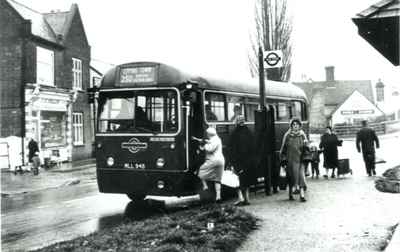 Red RF routes Red RF routes
Route 250
Page last updated 12 November 2020
One of the Central Area's most rural routes, relatively
unchanged for nearly 50 years but not surviving the retraction of
outside-GLC services.
The epitome of a
rural bus service - RF530 and passengers in Theydon Bois in
1964/5.
Photo Peter Osborn
collection
Dates of RF operation
1 Jul 59 to 23 Apr 76
Converted to OMO 18 Nov 64
(total 16 years 10 months, of which 5
years 5 months crew-operated)
Destinations
HORNCHURCH GARAGE and
EPPING TOWN (1 Jul 59 to 15 Jun 73)
ROMFORD STATION and EPPING TOWN (16 Jun
73 to 29 Nov 74)
ROMFORD STATION and EPPING St
Margaret’s Hospital (30 Nov 74 to 23 Apr 76)
Reason for single-deck operation
Not known, but as there is no obvious physical
restriction, it may have been due to the rural and infrequent
nature of the service. It is notable that all of the G-series
routes operated in the Romford area in the 1920s and early 30s were
single-decked.
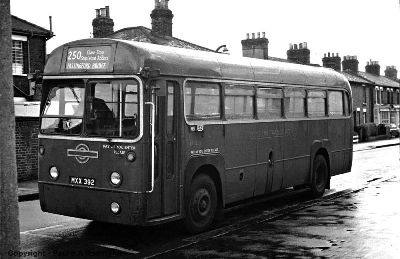
RF415 sits in Victoria Road, Romford, on the
stand used for the 250 and 86 in the early days of the Romford Ring
Road. This is soon after the route had been cut back from
Hornchurch in 1973, at which point short-workings to Passingford
Bridge were added to replace journeys on route 175. Thanks to
SCT61 for helping identify
the stand!
Photo © Paul Redmond
Route history
The 250 has its beginnings in an un-numbered independent route,
started by Capitol Omnibuses on 1 Sep 29 and running from Romford
to Abridge. The company used two single-deck TSMs, and
extended the route from Abridge to Epping Town in March 1930.
However, a fire at their South Street depot caused a suspension of
the service in July 1931; on re-introduction two months later, the
route was managed by LGOC and using their S-class
single-deckers. The route was formally taken over by the
General in November 1931, allocated to Hornchurch (RD)
garage and numbered G7 in the special Romford
area numbering system; the two Ss were replaced by a
one-year-old T. In the 1934
renumbering, the G7 became the 250.
The location of the southern terminus changed several
times while the Epping Cock to Romford Station
section remained constant. From the beginning, certain
journeys commenced from Romford Rainham Road/Gordon
Avenue, about a quarter mile south of Roneo Corner. This
became the full-time terminus on conversion to the 250, until
extended another quarter mile down Rainham Road to Laburnham Avenue
in 1936.
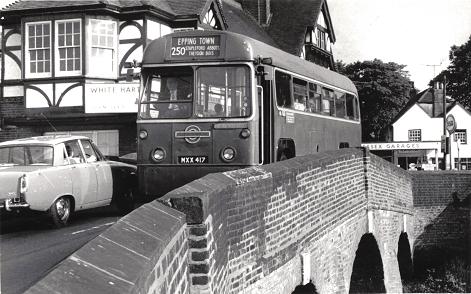 December 1939 saw the section south of Romford
Station dropped, replaced by an eastward extension to Gidea Park
Station and (Monday to Saturday) Emerson Park Wingletye
Lane (replacing the 256). On
these days, the Epping journeys ran only to Romford Station, with a
separate section from Romford Parkside Hotel (close to the
later site of North Street garage) to Emerson Park - a curious
arrangement this, with one part a long, infrequent rural route and
the other an intra-suburban service. It didn't last - the
Sunday section lasted six months and the Emerson Park journeys only
until November 1940, when the Gidea Park to Emerson Park
section was covered by new route 238
(to become one of the last OMO Cub
workings in the Central Area). The Gidea Park section was
in any case covered by the Scooter-operated 247. December 1939 saw the section south of Romford
Station dropped, replaced by an eastward extension to Gidea Park
Station and (Monday to Saturday) Emerson Park Wingletye
Lane (replacing the 256). On
these days, the Epping journeys ran only to Romford Station, with a
separate section from Romford Parkside Hotel (close to the
later site of North Street garage) to Emerson Park - a curious
arrangement this, with one part a long, infrequent rural route and
the other an intra-suburban service. It didn't last - the
Sunday section lasted six months and the Emerson Park journeys only
until November 1940, when the Gidea Park to Emerson Park
section was covered by new route 238
(to become one of the last OMO Cub
workings in the Central Area). The Gidea Park section was
in any case covered by the Scooter-operated 247.
OMO RF440 passes the White
Hart and crosses the River Roding at Abridge, on its way to Epping,
in June 1969.
Photo © JGS Smith, Peter
Gomm collection
Meanwhile, in October 1934, the 250 had a
partner route 250A, also
from Gordon Avenue, which diverged at Passingford Bridge for
Ongar. As would be expected in such sparsely populated
country, the routes were infrequent even then, with about six
through journeys each day on each. The
250A became the 123 (and later still the 175) when
double-decked in December 1936, whereupon the section south of
Romford Station was replaced by an increased service on the
250.
Improved frequencies in 1943 and again in 1946
increased the vehicle requirement to 4 (5 on Sundays), still met by
the now elderly petrol-engined 1T1s, occasionally supplemented by
ex-Tilling 3T3s. In October 1948, the first four of the
second batch of TDs went to Hornchurch for the 250, with a single
1T1 retained as a spare and for the Sunday service until a fifth TD
became available (on conversion of the 247 single-deck workings
and 248 to TD - from LTL and
T respectively - in April 1949).
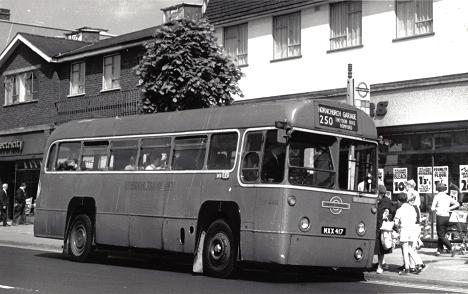 In May 1950, the route was extended
to Hornchurch Garage, an arrangement that was to stand (except for
Sundays in that first winter) for 23 years. At the same time,
the introduction of Sunday short workings between Epping and
Theydon Bois increased the vehicle requirement, leading to the
reappearance of two Ts (from the 252
allocation) on Sundays for that first summer. For the
summer of 1951, the shorts were replaced by an increase in
frequency of through journeys from 30 to 20 minutes. The
Sunday requirement was now 7, the extra 3 TDs being available from
the 248 and newly-converted 238. These extra summer Sunday
journeys worked each year until 1954. In May 1950, the route was extended
to Hornchurch Garage, an arrangement that was to stand (except for
Sundays in that first winter) for 23 years. At the same time,
the introduction of Sunday short workings between Epping and
Theydon Bois increased the vehicle requirement, leading to the
reappearance of two Ts (from the 252
allocation) on Sundays for that first summer. For the
summer of 1951, the shorts were replaced by an increase in
frequency of through journeys from 30 to 20 minutes. The
Sunday requirement was now 7, the extra 3 TDs being available from
the 248 and newly-converted 238. These extra summer Sunday
journeys worked each year until 1954.
RF440 again, on the same
day, now waiting in Epping to make its long journey back to
Hornchurch.
Photo © JGS Smith, Peter
Gomm collection
The next change was the re-allocation of the
250 and its four TDs to Romford North Street (NS)
garage on its opening on 12 Aug 53; the 238 and 248 did not
move across and it is presumed that the extra Sunday buses
were borrowed from RD.
In November 1958, the route was rerouted south of Epping
away from the direct 20 route to serve Ivychimneys Road,
opening up new bus territory. The next change was a curious
extension, of certain Monday to Saturday afternoon journeys and
just for eight weeks from February to April 1959, to Upminster
and over the old 249 (withdrawn the
previous year) to Corbets Tey. These ceased on the
reintroduction of the 249, now renumbered 248A and operating Monday to Friday
peaks only.
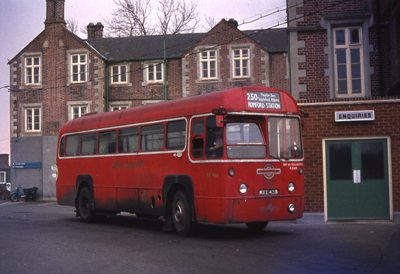 Conversion to RF operation came a few
months later, in July 1959, by which time it was the only
single-deck route operating in the Romford area. The route
was obviously suited to OMO conversion, and it was one of the first
four in November 1964. Conversion to RF operation came a few
months later, in July 1959, by which time it was the only
single-deck route operating in the Romford area. The route
was obviously suited to OMO conversion, and it was one of the first
four in November 1964.
Two weeks before the end
of RF operation, 10 Apr 76, RF461 stands at St Margaret's
Hospital.
Photo © John Parkin
The route continued unchanged (other than local rerouting on the
redevelopment of Romford centre) until cut back from
Hornchurch to Romford Station on 16 Jun 73. On the same
date, Monday to Saturday Passingford Bridge to Romford
Station shorts were introduced, in replacement for these journeys
on the immensely complex RT-operated 175 (whose through
journeys to Ongar were covered by the new 175A).
The final change during RF operation was an extension in Epping to
serve St Margaret's Hospital from November 1974.
The route was finally converted to BL operation in April 1976,
lasting less than eight months before discontinuation on
8 January 1977. During their early days, the BLs
were very unreliable, leading to gaps of up to three hours on this
hourly route. Consideration was given to bringing back RFs,
but this was not actioned. The 250 was replaced by
joining the route end-to end with BL-operated 247 (Romford to
Brentwood), making it then the longest route in London, with a
journey time of around 100 minutes.
The 247 was itself to be finally withdrawn in July 1981.
Following the withdrawal of TfL from the area north-west of
Passingford Bridge, the service between Abridge and Epping has
become embroiled in the turmoil of Harlow's bus
services. After a period of no provision, the Greater London
part of the route has been covered with one bus (except Sundays) by
TfL route 375 between Romford and Passingford Bridge (still in the
middle of nowhere); see Robert Munster's London Bus
Routes site.
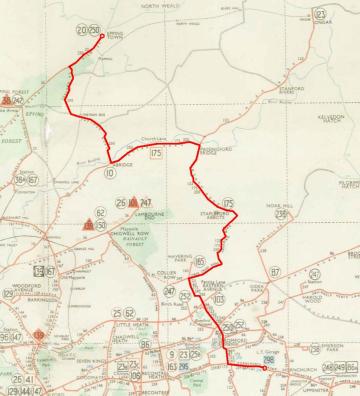 RF route in detail, with timing points
To 15 Jun 73: HORNCHURCH GARAGE, Hornchurch Road, Roneo
Corner, South Street, Romford Station, South Street, North
Street, Romford North Street
garage, North Street, Havering Road, Collier Row Lane,
Collier Row Clockhouse
Lane, Chase Cross Road, North Romford Chase Cross,
Havering Road, Orange Tree Hill, Havering Green, North Road, Stapleford Abbots Royal Oak, Oak
Hill Road, Stapleford Road, Passingford Bridge, Ongar Road,
Abridge White Hart,
Theydon Road (now Abridge Road), Theydon Bois Station, Coppice Row,
Piercing Hill, Theydon Road, Ivychimneys Road Theydon Road,
Ivychimneys Road, Central Drive, Station Road, High Street Epping,
EPPING TOWN Grove Lane.
The route in Romford was amended southbound three times and
northbound once between Dec 68 and Sep 69 as the road network
changed, then on 31 May 70, the final routing was adopted as
described below.
From 16 Jun 73: ROMFORD STATION, South Street, Western
Road, Mercury Gardens, Romford
Town Hall, St Edwards Way (E), North Street,
Romford North Street
garage, North Street, Havering Road, Collier Row Lane,
Collier Row Clockhouse
Lane, Chase Cross Road, North Romford Chase Cross,
Havering Road, Orange Tree Hill, Havering Green, North Road, Stapleford Abbots Royal Oak, Oak
Hill Road, Stapleford Road, Passingford Bridge, Ongar Road,
Abridge White Hart,
Theydon Road (now Abridge Road), Theydon Bois Station, Coppice Row,
Piercing Hill, Theydon Road, Ivychimneys Road Theydon Road,
Ivychimneys Road, Central Drive, Station Road, High Street Epping,
EPPING TOWN Grove Lane. Extended from 30 Nov 74
via Palmers Hill, The Plain to EPPING TOWN St Margaret’s
Hospital.
Terminal working at Hornchurch: turn in the garage - but
see notes below.
Terminal working at Romford Station: South Street, Brentwood
Road, George Street to stand, Victoria Road to South Street.
Terminal working at Epping Town: clockwise from High Street to
Hemnall Street, Grove Lane to stand, exit to High Street.
1949 map © London
Transport. Not the RF period, but the map has the advantage
(denied later) of showing the whole route to Epping.
Frequency
| Year |
Mon-Fri |
Sat |
Sun |
| 1936 |
120 mins |
120 mins |
120 mins |
| 1938 |
120 mins |
120 mins |
120 mins |
| 1941 |
120 mins |
120 mins |
123-138 mins |
| 1946 |
30-60 mins |
30-60 mins |
30-60 mins |
| 1951 |
30-60 mins |
30-60 mins |
30 mins |
| 1953 |
30-60 mins |
40-60 mins |
20 mins |
| 1959 |
60 mins |
60 mins |
30 mins |
| 1964 |
60 mins |
60 mins |
75 mins |
| 1969 |
60 mins |
60 mins |
75 mins |
| 1971 |
60 mins |
60 mins |
80 mins |
| 1976 |
60 mins * |
60 mins * |
72 mins |
|
* more frequent Romford - Passingford Bridge
|
The route took about 60 minutes from Romford to Epping Town,
another 6 minutes from Hornchurch. The July 1967 timetable is
here.
Faretable
The faretable for May 1965 is here. Note the minimum fares in
operation for northbound journeys from central Romford. Peter
Crabb-Wyke confirms that the RFs did indeed carry 'Minimum Fare'
slip plates.
RF allocation
PVR 1959 (Jul): Mon-Fri 3, Sat 3, Sun 5
PVR 1963 (Jun): Mon-Fri 3, Sat 3, Sun 2
PVR 1964 (OMO, Nov): no change
PVR 1973 (Jun): Mon-Fri 4, Sat 4, Sun 2
Memories
Whilst working the 250 in September 2006, a former North
Street driver (unfortunately he didn't give us his name) came
aboard and shared some memories of working RFs on the 250 in the
early 70s. One of the earliest was of a regular passenger, an
old lady who boarded at Hammonds Farm, by the Rabbits pub north of
Stapleford Abbots. Her payment for the fare to
Epping would be either 3/- or half-a-dozen eggs.
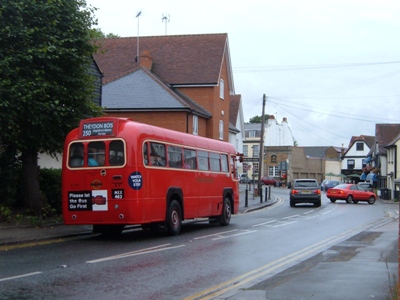 He also recalled that the Hornchurch terminus involved
turning in the garage, except for the last journey at night by
which time the garage was too full to turn and surrounding streets
were used. These became increasingly blocked with cars and he
wondered whether this was a reason behind the route being cut back
to Romford from 1973.
Seeing the mounting for the Ultimate ticket machine on the cab
door, he recalled that these had originally been situated on the
inside of the door, but this allowed unscrupulous drivers to
reissue old tickets and pocket the fare, so was changed.
Generally, his memory of the RF was of a nice bus to drive, and
much nicer than the BLs that followed them.
Re-creation
As part of the NLTS Theydon Bois event in 2006, RFs worked the
250.
RF486 in Abridge, about to turn right across the
River Roding towards Theydon Bois. Such short-workings
were not part of the the LT service, shorts from Romford turned at
Passingford Bridge. The forecourt of the Blue Boar in
the distance was the terminus for RTs on the
10.
Photo © Peter Osborn
|
|